New stadiums: Berkeley, Lawrence, New York
source: StadiumDB.com; author: michał
 Each of them is different. In Berkeley there’s a new structure embedded in historical footprint. In New York a brand new stadium that bears some features of the past one. And in Lawrence one that needs renovation to keep up.
Each of them is different. In Berkeley there’s a new structure embedded in historical footprint. In New York a brand new stadium that bears some features of the past one. And in Lawrence one that needs renovation to keep up.
Advertisement
California Memorial Stadium, Berkeley
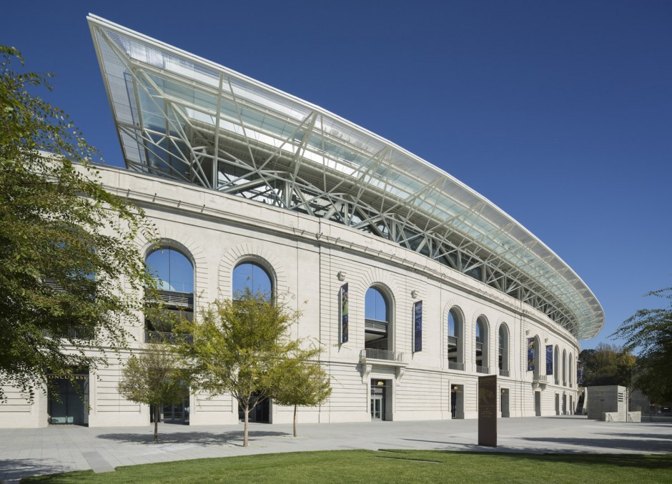
After the announcement of two Californian giants in Los Angeles and Pasadena in early 1920s, Berkeley also decided to get a new and impressive stadium. Initial cost was covered in just 10 days, as the 10,000 seat licenses ($100 each) were snapped almost on the spot.
Despite controversies and other options, entry to the Strawberry Canyon in eastern Berkeley was selected as preferred location for the stadium, proving over the years to be a priceless choice. Fans on both sides of the stadium are offered a unique view. Those in the east may overlook western San Francisco Bay waters with the stadium’s elevated location. Meanwhile spectators in the west get a great view of the Berkeley Hills. The stadium and its unique setting were listed among the federal historic places in 2006, gaining legal protection.
Construction took less than a year with the stadium’s simple, partly landfill-based structure. Its huge sunken bowl remained almost completely unchanged until 2010, when almost all of the western side was torn down, leaving only parts of the original neoclassical facades. New stands was built in this place by 2012, though it differs very little at first sight from the old one.
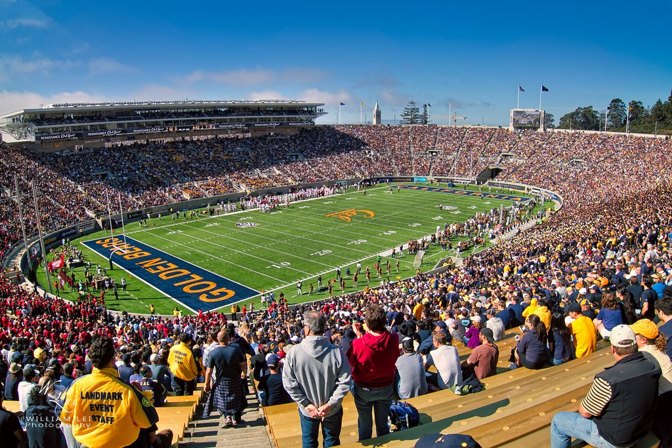 Photo: Wil Lei
Photo: Wil Lei
Historical protection forced retaining the very same footprint and almost identical geometry, while the new corporate zones and concession areas are less visible. As part of the revamp a glass terrace was created atop the stadium, allowing guests to get a view of both the stadium’s interior and the panorama of Berkeley.
Initial capacity was set at over 72,000 people, but for major events it could be raised to over 80,000. Today the number is much lower, owing partly to more comfortable seat allocation in the west. Some argue the total number of spectators may actually exceed this stadium’s size, because top games draw people also to a nearby hill known as the Tightwad Hill.
Anchor tenants of the stadium remain unchanged since the earliest days of this stadium. It’s the Golden Bears NCAA side. However the name’s meaning has changed since the opening. Initially the Memorial was dedicated to Californians fallen during WWI. Since 2012 the name refers to all locals who lost their lives fighting for the country.
KU Memorial Stadium, Lawrence
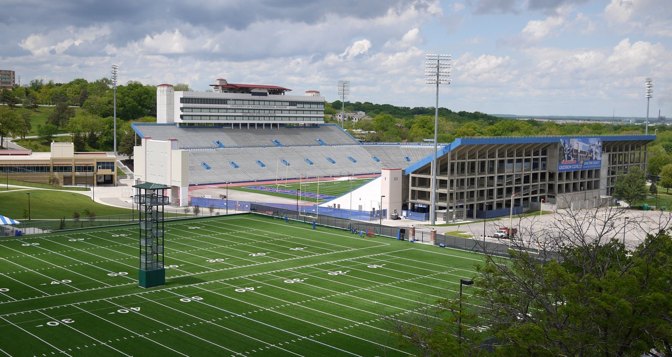 Photo: Brent Flanders
Photo: Brent Flanders
Although the stadium was opened in 1921, efforts to create a prosperous sports complex in Lawrence date back to 1890s. Gradual development of local sport led to a new stadium being planned in 1920, which was mostly funded by the community – students, faculty and alumni. Boosted by coinciding American football success, they raised $225,000, a very impressive sum at that time. The new stadium was dedicated to University of Kansas representatives fallen during WWI.
Work was launched already in 1920 along the design ordered by Director of Athletics Forrest C. “Phog” Allen, who appreciated a semi-open horseshoe layout. To achieve this the south side was left empty and remains such today. During opening in 1921 the stadium had only two side stands, but by 1927 it received its desired form, accommodating 38,000 people.
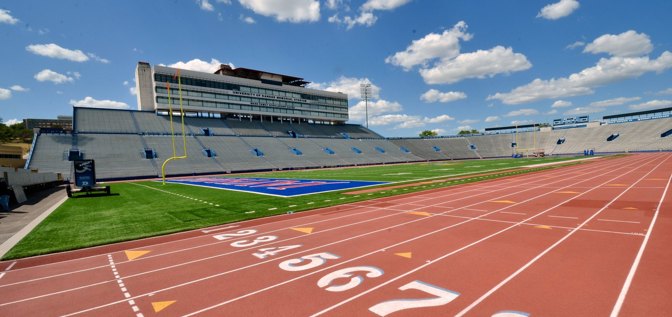 Photo: Brent Flanders
Photo: Brent Flanders
Further revamps came in 1960s, as the west stand got its additional rows, followed by almost identical addition on the east side in 1965. By late twentieth century the ground was seriously outdated and thus two offices joined forces to redesign it. The wets grandstand saw expansion of the press/corporate facilities above regular bleachers, while floodlight masts and a giant screen were also mounted. More changes are expected in upcoming years, especially in terms of commercial potential.
Week-to-week use is provided by NCAA team Kansas Jayhawks. Meanwhile the provision of an athletic track assures that annual 3-day Kansas Relay continues to take place every year in April.
Yankee Stadium, New York
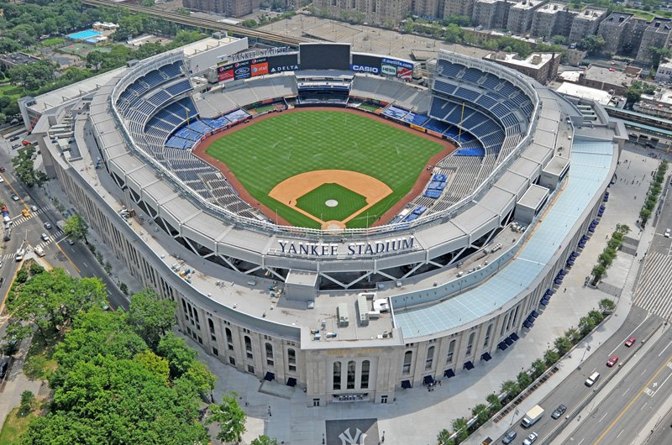
The need of building new baseball stadium for Yankees was declared by owner George Steinbrenner already in 1980s, but he waited until the next century for the dream to become reality. While several “plan B” locations were considered, eventually the most desired one in South Bronx was chosen, right across the street from where the first stadium was set in 1923.
And the new stadium was ordered to resemble its predecessor very vividly. Global architecture practice Populous took the job of mixing history with modern, commercialized multi-event approach. The visual effect is interesting. Outer cladding of granite and limestone is a monumental, quasi-historical one. Inside the stands one immediately notices the unique frieze on the roof, just like the one installed in 1923 that became Yankee Stadium’s trademark.
Inside is much more spacious than in the old stadium, providing not only more, but also much more diversified consumer areas. Spacious hall welcoming all fans assures the monumental feeling is not lost after entering the stadium.
From there fans may enter their respective areas, also planned to boost revenues. 68 skyboxes were included (compared to 19 at the old stadium) and 4,300 business seats (none at the old one). The seating layout shows a significant difference. Most of the seats now are located in the lower areas of the stadium, while with the predecessor most were in the vast upper deck.
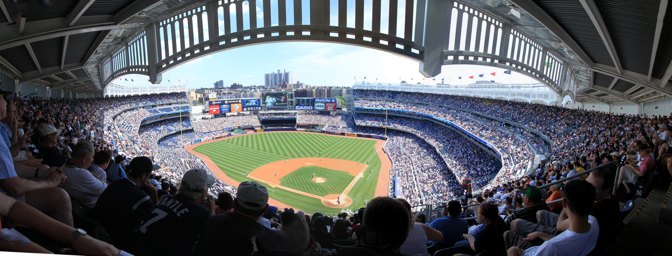 Photo: Peter
Photo: Peter
Construction was launched officially in August 2006 and took almost 3 years. Throughout that period Yankees played at their old home, which wasn’t demolished until after the baseball team relocated.
Since it opened in April 2009, the stadium remains NY city’s prime baseball location, but also hosts various other events, like concerts and American football games. More importantly for StadiumDB.com, there’s also association football being played on the vast field. In early years this discipline was represented only by friendly fixtures of top European games, but in 2014 it was announced that NY City FC will play at least 3 seasons here before moving to a purpose-built stadium.
Yankee Stadium’s most controversial feature is the price tag. $1.5 billion makes it one of the most expensive stadiums ever, in any discipline, despite not being among the largest at the same time. As many critics emphasize, the bill was footed by taxpayer money mostly, because Yankees contributed less than half of the price and were given tax-exempts too.
Advertisement

 StadiumDB
StadiumDB